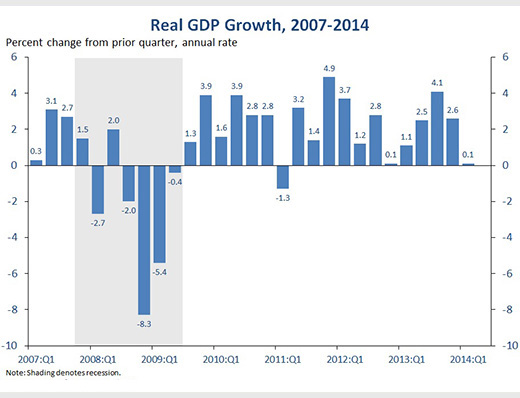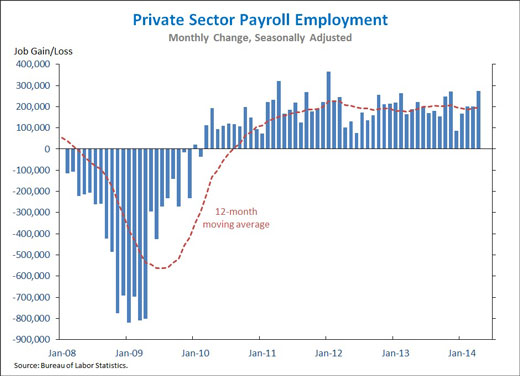Council of Economic Advisers Blog
Second Estimate of GDP for the First Quarter of 2014
Posted by on May 29, 2014 at 10:19 AM EDTToday’s GDP revision was due almost entirely to a downward revision to the highly volatile inventories category, with small upward revisions to consumer spending and business fixed investment being offset by small downward revisions to net exports and state and local purchases. Overall the first quarter was subject to a number of notable influences, including historically severe winter weather, which temporarily lowered growth. A range of more up-to-date data from March and April, including jobs, manufacturing, housing and other indicators, provide a more accurate and timely picture of where the economy is today and show that it continues to recover from the worst recession since the Great Depression. The President will do everything he can either by acting through executive action or by working with Congress to push for steps that would raise growth and accelerate job creation, including fully paid-for investments in infrastructure, education and research, a reinstatement of extended unemployment insurance benefits, and an increase in the minimum wage.
FIVE KEY POINTS IN TODAY’S REPORT FROM THE BUREAU OF ECONOMIC ANALYSIS
1. Real gross domestic product (GDP) fell 1.0 percent at an annual rate in the first quarter of 2014, according to the second estimate from the Bureau of Economic Analysis. This drop follows an increase of 3.4 percent annual pace in the second half of 2013. Looking at the various components of GDP, consumer spending grew at a rapid pace, mainly reflecting sharp increases in health care and utilities consumption, while the other elements of consumer spending on net rose only slightly. Consumer spending on food services and accommodations fell for the first time in four years, one of several components that was likely affected by unusually severe winter weather. Exports and inventory investment, two particularly volatile components of GDP, also subtracted from growth.
 Learn more about Economy
Learn more about EconomyAlongside Expanded Coverage, Underlying Slow Growth in Health Costs Is Continuing
Posted by on May 27, 2014 at 12:13 PM EDTIt is no secret that the last several months have seen dramatic progress in expanding access to high-quality, affordable health insurance. Over the Affordable Care Act’s first open enrollment period, more than 8 million people signed up for coverage through the Health Insurance Marketplaces, and, through March 2014, 4.8 million people gained coverage through Medicaid or CHIP. Meanwhile, multiple independent surveys have reported sharp drops in the share of Americans without health insurance.
What is not widely known is that the last several months have also seen a steady stream of good news on health care costs. This good news suggests that even as coverage expands, the underlying slow growth in health care prices, per-enrollee spending, and premiums that we have seen in recent years is continuing. That slow cost growth, which is thanks in part to the Affordable Care Act, is helping keep families’ premiums and out-of-pocket costs down, making it easier for businesses to hire workers and pay a good wage, and improving our fiscal future.
Learn more about Health CareMaking Full Use of America's Talent
Posted by on May 19, 2014 at 11:40 AM EDTThis was originally posted on the Huffington Post, and is part of a series of essays about the issues facing working families in the 21st century, leading up to the White House Summit on Working Families on June 23, 2014.
You can learn more about the Summit and how you can get involved at www.workingfamiliessummit.org.
I told a friend recently that I thought that I was failing at everything -- my kids weren’t getting enough of me, I wasn’t doing everything that I wanted to at work, and I wasn’t spending enough time with my partner. Her response was to congratulate me for getting my work-life balance just right.
As an economist, I’ve spent my career thinking about trade-offs and how to make good decisions given all of the constraints -- like money, time, and opportunities -- that we face. And I know it is hard. When kids are young, their demands on parents’ time is enormous, and the same thing is true when partners or parents or children are sick. We all have periods in our life where our home needs are greater than at other times.
Most people I know address these challenges by eliminating everything outside of work and family. Getting together with childless friends becomes a luxury, exercise becomes impossible --unless you count lifting a heavy load of laundry with one arm, while holding an infant with the other, “exercise” -- and a good night’s sleep becomes a distant memory. A friend recently complained to me that the grocery store she placed online orders with was no longer taking orders between 2 and 5 a.m. “But that’s my only window for grocery shopping,” she wailed.
And yet, my friends and I are among the lucky ones. I’ve spent most of my career as an academic. I work hard on research, teaching, and writing, but I set my own hours and I control my own pace of work. When I had each of my children, I had months during which I was able to work from home, doing only as much as I could handle. My partner, a fellow academic, had the same luxury.
The Employment Situation in April
Posted by on May 2, 2014 at 9:26 AM EDTEmployment growth was solid in April, as businesses added jobs for the 50th consecutive month, and the unemployment rate fell. The employment data can fluctuate from month-to-month, and while this month’s report happens to be above expectations, it is still broadly consistent with the recent trends we have been seeing in the labor market. The President continues to emphasize that more can and should be done to support the recovery, including acting on his own executive authority to expand economic opportunity, as well as pushing Congress for additional investments in infrastructure, education and research, an increase in the minimum wage, and a reinstatement of extended unemployment insurance benefits. In fact, CEA estimates that because of the failure to continue extended benefits into 2014, the economy has already incurred the loss of 80,000 jobs so far this year. Failure to reinstate extended unemployment insurance benefits is expected to cost another 160,000 jobs over the balance of the year.
FIVE KEY POINTS IN TODAY’S REPORT FROM THE BUREAU OF LABOR STATISTICS
1. The private sector has added 9.2 million jobs over 50 straight months of job growth. Today we learned that total nonfarm payroll employment rose by 288,000 in April, driven by a 273,000 increase in private employment. Job growth in February and March was revised up, so that that over the past twelve months, private employment has risen by 2.4 million, or an average of 198,000 a month. This is slightly faster than the pace of job gains over the preceding twelve-month period (182,000 a month).
Learn more aboutAdvance Estimate of GDP for the First Quarter of 2014
Posted by on April 30, 2014 at 9:58 AM EDTToday’s GDP estimate is subject to a number of notable influences, including historically severe winter weather, which temporarily lowered growth in the first quarter. The report also shows the positive impact of the implementation of the Affordable Care Act which, together with continued slowing in health costs, helped strengthen the economy in the first quarter. The President will do everything he can either by acting through executive action or by working with Congress to push for steps that would raise growth and accelerate job creation, including fully paid-for investments in infrastructure, education and research, a reinstatement of extended unemployment insurance benefits, and an increase in the minimum wage.
FIVE KEY POINTS IN TODAY’S REPORT FROM THE BUREAU OF ECONOMIC ANALYSIS
1. Real gross domestic product (GDP) rose 0.1 percent at an annual rate in the first quarter of 2014, following the 3.4 percent annual pace in the second half of 2013. Looking at the various components of GDP, consumer spending grew at a rapid pace, mainly reflecting sharp increases in health care and utilities consumption, while the other elements of consumer spending on net rose only slightly. Consumer spending on food services and accommodations fell for the first time in four years, one of several components that was likely affected by unusually severe winter weather. Exports and inventory investment, two particularly volatile components of GDP, also subtracted from growth.
 Learn more about Economy
Learn more about EconomyBusiness School Deans Meet to Discuss Best Practices for a 21st Century Workplace
Posted by on April 16, 2014 at 5:04 PM EDTAs part of the lead up to the White House Summit on Working Families, we have been seeking input from a wide variety of stakeholders to identify best practices for developing workplaces that work for all Americans and better meet the needs of women and working families. We did not think this goal could be achieved without thinking of the business leaders of tomorrow, and that is why today, we met with a group of deans from our nation’s leading business schools to discuss best practices for business schools that can better prepare their students for the increasing importance of women in the labor force and the prevalence of employees with families where all parents work.
Learn more about , Women
- &lsaquo previous
- …
- 6
- 7
- 8
- 9
- 10
- 11
- 12
- 13
- 14
- …
- next &rsaquo
White House Blogs
- The White House Blog
- Middle Class Task Force
- Council of Economic Advisers
- Council on Environmental Quality
- Council on Women and Girls
- Office of Intergovernmental Affairs
- Office of Management and Budget
- Office of Public Engagement
- Office of Science & Tech Policy
- Office of Urban Affairs
- Open Government
- Faith and Neighborhood Partnerships
- Social Innovation and Civic Participation
- US Trade Representative
- Office National Drug Control Policy
categories
- AIDS Policy
- Alaska
- Blueprint for an America Built to Last
- Budget
- Civil Rights
- Defense
- Disabilities
- Economy
- Education
- Energy and Environment
- Equal Pay
- Ethics
- Faith Based
- Fiscal Responsibility
- Foreign Policy
- Grab Bag
- Health Care
- Homeland Security
- Immigration
- Innovation Fellows
- Inside the White House
- Middle Class Security
- Open Government
- Poverty
- Rural
- Seniors and Social Security
- Service
- Social Innovation
- State of the Union
- Taxes
- Technology
- Urban Policy
- Veterans
- Violence Prevention
- White House Internships
- Women
- Working Families
- Additional Issues



